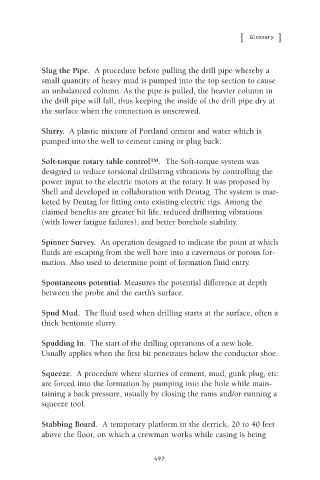Page 521 - Practical Well Planning and Drilling Manual
P. 521
Appendix NEW! revised 11/00/bc 1/30/01 3:30 PM Page 497
[ ]
Glossary
Slug the Pipe. A procedure before pulling the drill pipe whereby a
small quantity of heavy mud is pumped into the top section to cause
an unbalanced column. As the pipe is pulled, the heavier column in
the drill pipe will fall, thus keeping the inside of the drill pipe dry at
the surface when the connection is unscrewed.
Slurry. A plastic mixture of Portland cement and water which is
pumped into the well to cement casing or plug back.
Soft-torque rotary table control™. The Soft-torque system was
designed to reduce torsional drillstring vibrations by controlling the
power input to the electric motors at the rotary. It was proposed by
Shell and developed in collaboration with Deutag. The system is mar-
keted by Deutag for fitting onto existing electric rigs. Among the
claimed benefits are greater bit life, reduced drillstring vibrations
(with lower fatigue failures), and better borehole stability.
Spinner Survey. An operation designed to indicate the point at which
fluids are escaping from the well bore into a cavernous or porous for-
mation. Also used to determine point of formation fluid entry.
Spontaneous potential. Measures the potential difference at depth
between the probe and the earth’s surface.
Spud Mud. The fluid used when drilling starts at the surface, often a
thick bentonite slurry.
Spudding In. The start of the drilling operations of a new hole.
Usually applies when the first bit penetrates below the conductor shoe.
Squeeze. A procedure where slurries of cement, mud, gunk plug, etc.
are forced into the formation by pumping into the hole while main-
taining a back pressure, usually by closing the rams and/or running a
squeeze tool.
Stabbing Board. A temporary platform in the derrick, 20 to 40 feet
above the floor, on which a crewman works while casing is being
497

